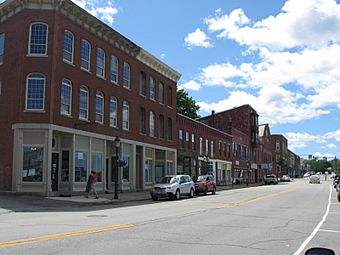Calais Historic District facts for kids
Quick facts for kids |
|
|
Calais Historic District
|
|

Main Street in Calais
|
|
| Location | Church, Main and North Sts., Calais, Maine |
|---|---|
| Area | 2 acres (0.81 ha) |
| Architectural style | Greek Revival, Italianate, Romanesque Revival |
| NRHP reference No. | 78000204 |
| Added to NRHP | December 20, 1978 |
The Calais Historic District is a special area in Calais, Maine. It's filled with old buildings from the 1800s. Many of these buildings were built after a big fire in 1870. They show off a cool style called Italianate architecture. This district was added to the National Register of Historic Places in 1978. This means it's an important historical place.
Contents
What is the Calais Historic District?
This historic district covers one city block in the center of Calais. It includes buildings on Main Street, North Street, and Church Street. Most of the buildings here were built right after a huge fire in 1870. They are mostly made of brick and show off the popular architectural styles of that time.
A Look Back at Calais's History
Calais is a city in eastern Maine, right on the Saint Croix River. This river forms the border between the United States and Canada. Calais became a city in 1850. Back then, it was a busy place for cutting down trees (lumber) and building ships.
In August 1870, a terrible fire swept through the city's main business area. Many wooden buildings were destroyed. But the people of Calais didn't give up! Within just one year, a lot of the area was rebuilt. Most of the new buildings were made of brick, which is much safer from fires.
Buildings in the District
The historic district includes a stretch of buildings on the south side of Main Street. This is between North Street and Church Street. It also has a few buildings on North and Church Streets themselves.
Main Street Buildings
Almost all the buildings on Main Street in this district were built after the 1870 fire. They mostly feature the Italianate style. This style was very popular in the late 1800s. It often includes decorative brackets under the roof and tall, narrow windows.
One special building is the Hill Building at 153 Main Street. It was built earlier, in 1847. This three-story brick building shows the Greek Revival style. This style often looks like ancient Greek temples. Two other buildings on the east side of North Street, next to the Hill Building, are also Greek Revival. They were built in the 1840s and 1850s.
Church Street Buildings
Two important public buildings on Church Street are part of the district. The Calais City Hall, at 15 Church Street, was built in 1901. It's designed in the Romanesque Revival style. This style often uses round arches and strong, heavy stone or brick. H. A. Crosby designed City Hall.
The old fire station, at 13 Church Street, was built in 1874. Its tall tower and bell tower were added later, in 1895-1896. These buildings show how the city grew and changed over time.



